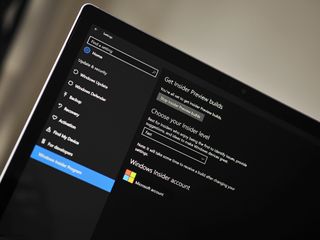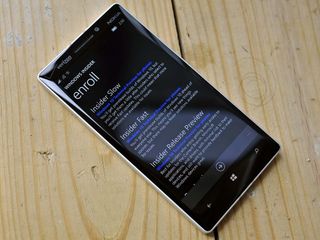Which Windows Insider Ring is best? All you need to know about Slow, Fast, and Release Preview rings
Rings, rings, rings! Which is the best Windows Insider ring for you and what are the risks involved? We break it all down for you in this comprehensive article.

Back in February, Microsoft introduced a third Ring for the Windows Insider program for PC and Phones called Release Preview. That was in addition to the already existing Fast and Slow Rings.
While some of the rings seem self-explanatory, we still see frequent requests by users as to which Ring is best for them. In this article, we'll try our best to break it down.
A word of caution about Insider rings
The important thing to remember about the Windows Insider program and Rings is that you can always go up in build numbers for example 10586.218 to 10586.242, but you cannot go back down e.g. 14332.1001 back to 10586.218 without resetting or reflashing your PC and phone, respectively.
That means you can go from Production to Fast Ring, but you cannot go back to Production without a little footwork.
If you are on Windows 10 or Mobile, and you are going into Fast Ring, it will be a small project to go back to any other build like Production or Release Preview. Just keep that in mind when reading below and before deciding.
Speed in enrolling
When you are enrolling in the Windows Insider program there is some difference in time for it to kick in:
- PC – For PCs and laptops, once you go from Production to any other Ring for the first time it could take upwards of 24 hours before you get the OS update. Once enrolled, however, you can change rings immediately.
- Phone – Phones, for some reason, are instant. As soon as you enroll, your phone goes into that ring and can get the OS update right away. The same applies for changing rings.
Types of Rings
Fast Ring

Fast Ring is ideal for those with a second PC or Windows phone who don't mind taking some risks. While you can easily use Fast Ring on your primary device, you are taking a risk of a less-than-stellar user experience. This risk is doubly true for Mobile and phone where the new bugs could be bothersome. As Fast Ring evolves for new milestones e.g. Redstone 1 they do become more stable.
Get the Windows Central Newsletter
All the latest news, reviews, and guides for Windows and Xbox diehards.
There is little tolerance for complaining about bugs or issues with Fast Ring as that is what you are signing up for when you join. Microsoft knows Fast Ring is buggy, which is why it exists. Nonetheless, you are highly encouraged to report those bugs and give feedback using the Feedback Hub.
What is a branch? - Fast Ring is a different branch of the OS than what is currently shipping on new PCs and phones. Branch is a term for developers that means the OS is splintering off the main code base so Microsoft (in this case) can do things like refactoring the OS, add new features, and change core aspects of the OS.
Later, this branch merges into the main OS when an official OS update is released for everyone on Windows 10. For example, the current branch is codenamed "Redstone 1" but will be released to everyone as the Windows 10 Anniversary Update sometime in July (rumored).
Windows 10 Anniversary Update - All you need to know!
A more concrete way to see a branch is in the build numbers. The current production release is 10586.xxx or 10586.218 whereas the "Redstone 1" branch is 14xxx.xxxx or 14332.1001. To see your OS version just type in "winver" into the Cortana/Search box on your desktop or Settings and About on the phone.
Frequency - Updates usually arrive for Fast Ring every two weeks, although sometimes the frequency is even higher. Your phone or PC will be out of commission during the update process, and this could interrupt your workflow.
The tradeoff with the risks associated with Fast Ring is you get new features first, which is great for enthusiast users. However, sometimes those new features are only partially operational, so it can be a mixed back until more updates come through.
App Rings - Finally, there are also 'app fast rings' where certain core apps like Outlook and Groove can get different updates (build numbers) than Production or Release Preview. Since new OS features rely on the OS and the corresponding apps, this makes sense.
Slow Ring
Slow Ring is a harder to classify if you are new to the Insider program. The short version is that you are still taking a risk if you want this on your daily machine or phone, but it is a few builds behind the Fast Ring, so it's not as risky if that makes sense.
Here are some other bits about Slow Ring:
- Slow Ring is more stable than Fast Ring
- Slow Ring has fewer updates than Fast Ring i.e. every six weeks or more
- Slow Ring is the same branch as Fast Ring
- You still get new features, but obviously not as quickly as Fast Ring
Slow Ring is still in the "experimental" category for Windows 10 as an OS, but it is not as risky. This, however, is where it gets grey as there are still some bugs and quirks, but people's thresholds vary as to what is a buggy and what is not. Plus, your experience depends on your device, drivers, etc.
Release Preview
Release Preview is the newest and perhaps more interesting ring for those who want the latest bits of Windows 10 and Windows 10 Mobile, but do not want to leave the current branch.
In other words, Release Preview is just an update to 10586.xxx. For instance, the version of the OS that is released for the public right now is 10586.218, but Release Preview is 10586.240 for PC and 10586.242 for Phone.
Once or twice a month Microsoft releases cumulative updates (or patches) for PCs and Mobile. These usually fall on "Patch Tuesday". These updates are bug fixes, security patches, improvements to the OS, general enhancements and more.

Everyone gets these updates eventually, but Release Preview users get them earlier. You will rarely get new features with this Ring, but you can be assured of its stability. If anything, your phone or PC will get better with this update as it just Microsoft optimizing the OS for everyone.
If you are happy with Windows 10 or Windows 10 Mobile but want fixes and patches early then this is the build for you. Feel free to install this on your main PC or daily use phone because you are going to get it in a few weeks (at most) anyway!
Production Ring
Finally, there is technically a fourth ring called Production. However, you only see this option given if you are already enrolled in a Fast, Slow, or Preview Release.
Production simply means the publicly available version of Windows 10 and Windows 10 Mobile that is open to everyone.
You only choose this ring when you want to stop getting Insider updates.
Note, however, that if you are in the Fast or Slow ring, going back to Production does not roll back your phone to the main branch. Instead, you will need to use the Windows Device Recovery Tool (WDRT) to re-flash your phone or use the rest feature in Windows 10 for PC.
You can quickly go up the OS ladder, but getting back down is tricky.
Wrap up
Microsoft's Window Insider program is a vast and sprawling machine that is constantly growing and improving. Rings are an important part of that project to make "Windows as a Service" (WaaS) where the OS is just constantly and perpetually updated and improved.
Which ring you choose depends on how many devices you may have, how much of a risk taker you are and how many issues you are willing to deal with for a release.

Personally speaking, I think Release Preview will give you the most stable, consistent and rewarding experience if you are okay with not getting the fun stuff in Fast or Slow Ring. If you just need your PC or phone to work then go with Release Preview.
If you have a spare Windows Phone laying around or an old tablet feel free to put the Fast or Slow ring on it. If you have few issues, consider it for your primary phone or PC. Or, if you just don't mind bugs, possible battery issues, etc. then just go for it. You could always re-flash your PC or phone to the main branch; it may take you 30-90 minutes, but it's not the end of the world if something goes wrong.
Just remember to back up everything!

Daniel Rubino is the Editor-in-chief of Windows Central. He is also the head reviewer, podcast co-host, and analyst. He has been covering Microsoft since 2007, when this site was called WMExperts (and later Windows Phone Central). His interests include Windows, laptops, next-gen computing, and watches. He has been reviewing laptops since 2015 and is particularly fond of 2-in-1 convertibles, ARM processors, new form factors, and thin-and-light PCs. Before all this tech stuff, he worked on a Ph.D. in linguistics, watched people sleep (for medical purposes!), and ran the projectors at movie theaters because it was fun.
